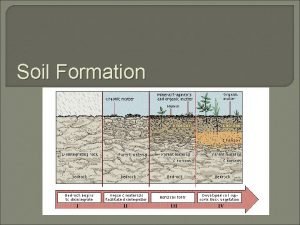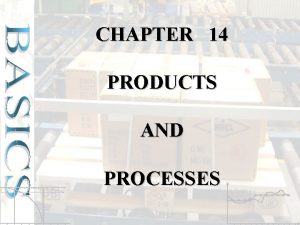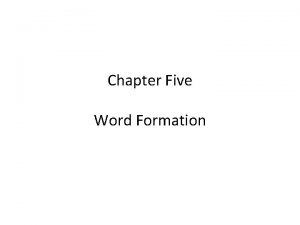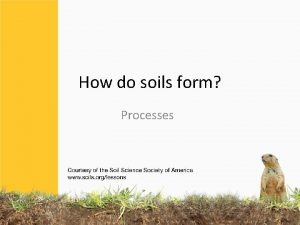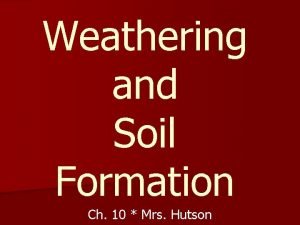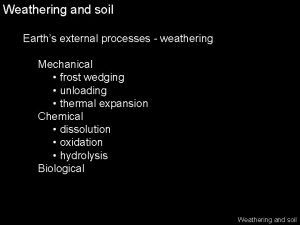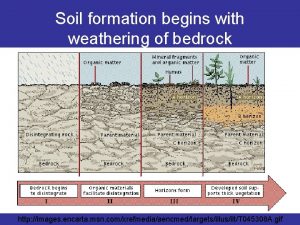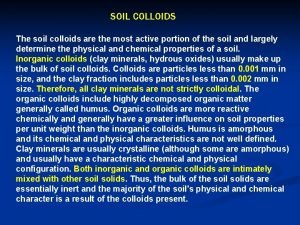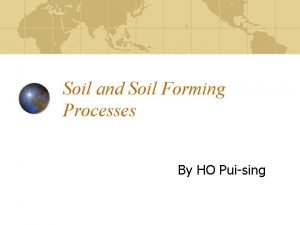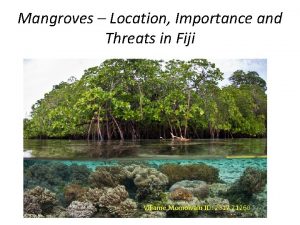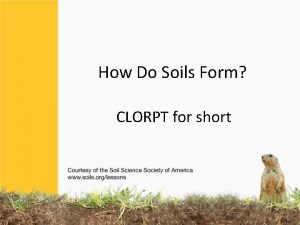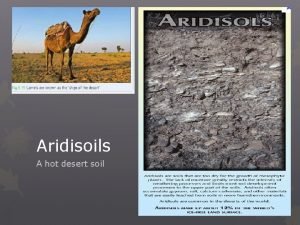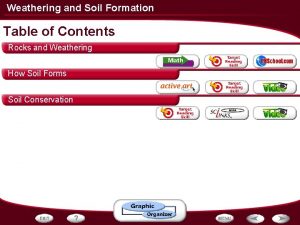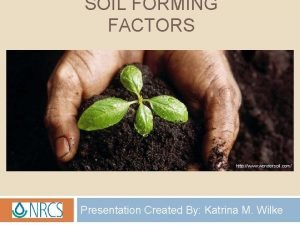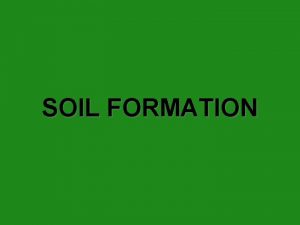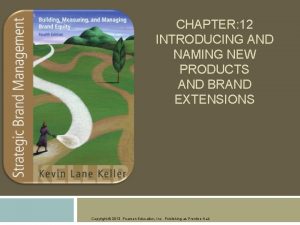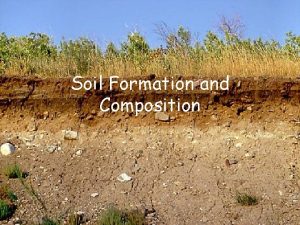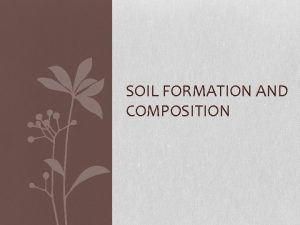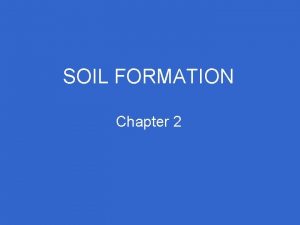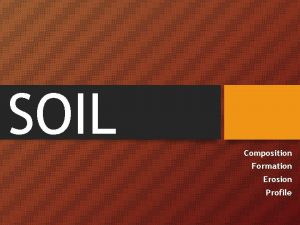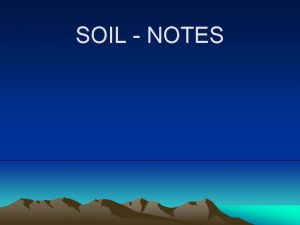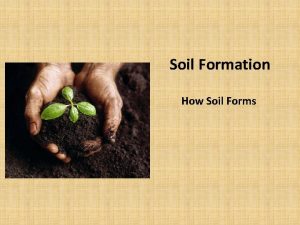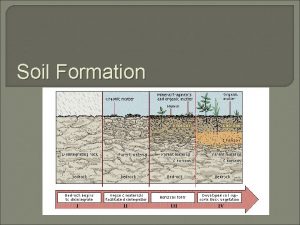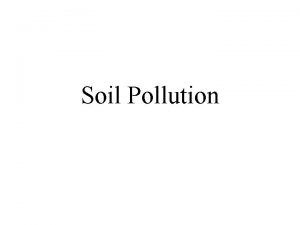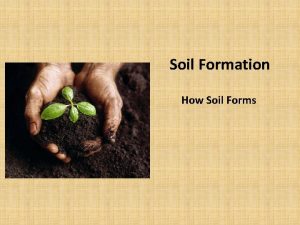Soil Formation Processes and Products Soil Soil is





























- Slides: 29

Soil Formation Processes and Products

Soil • Soil is a dynamic, living system. • It facilitates the relationship between living and non-living components of terrestrial ecosystems. Soil Composition Organisms 5% Organic Matter 5% Inorganic Matter 40% Water & Air 50%

Soil • It is critical for the long term health of agriculture, forestry, and urban influenced ecosystems. Soil Composition Organisms 5% Organic Matter 5% Inorganic Matter 40% Water & Air 50%

Soil Texture • Refers to the proportion of sand, silt, and clay particles present in soil. • Texture is the determining factor for soil qualities such as soil fertility and water holding capacity.

Soil Texture Triangle A Soil Texture Triangle gives names to various combinations of clay, silt, and sand. ØClay: Very small particle size; binds water and nutrients and makes soils feel sticky. ØSilt: Larger than clay particles; makes soils feel slippery. ØSand: Largest particle size; makes soils feel gritty. ØLoam: Mixture of clay, silt, & sand; best suited for crops.

Soil Porosity • Pores are spaces between particles. • Clay has extremely small pores (micropores), which allow them to retain water. Particles Size Sand Silt Clay

Soil Porosity • Sandy soils have large pores, which allow for greater drainage. Particles Size Sand Silt • Loam soil has a combination of pores sizes üGreat for air and water movement üBest for plant growth Clay

Soil Porosity and Characteristics Sandy Soils Ø Large pores (macropores) Ø Drains quickly after rain or watering Ø Dries out quickly Silt Soils Ø Medium Pores Ø Drains fairly well Ø Holds more moisture than sandy soils Ø Easily compacted Clay Soils Ø Small pores (micropores) Ø Drains slowly

Soil Horizons • Distinct layers of soil. • Formed by five primary factors: Parent material, climate, topography, vegetation, and time. Photo provided by the James Hutton Institute

Soil Horizons { } O Horizon: Litter Layer • Organic matter – Loose leaves & organic debris that are beginning to decompose. • Relatively thin in prairie and agricultural soils, significantly thicker in forest soils. Photo provided by the Plant and Soil Science e. Library: http: //passel. unl. edu/pages /

Soil Horizons { } A Horizon: Topsoil Organic matter mixed with minerals, often referred to as topsoil. • Relatively thicker in grassland soil. • Highest nutrient availability. • Abundant biological activity. Photos provided by the Plant and Soil Science e. Library : http: //passel. unl. edu/pages /

Soil Horizons B Horizon: Leaching or Accumulation Layer { } Movement of minerals and organic matter both into and out of this layer, depending on climate and vegetation. • Can result in a horizon of various colours, texture, and nutrient levels. Photos provided by the Plant and Soil Science e. Library : http: //passel. unl. edu/pages /

Soil Horizons C Horizon: Subsoil Also referred to as parent material, which may have originated from glaciers, rivers, volcanic deposits, or weathered bedrock. { Photos provided by the Plant and Soil Science e. Library : http: //passel. unl. edu/pages / } Ca. CO 3 DEMO • Higher concentration of clay. • Accumulation of leeched matter.

Soil Horizons D Horizon: Bedrock In Canada, the majority of our soils originate from past glacier activity. Therefore, bedrock is not commonly found in southern Saskatchewan, but is present in forest soils in northern Saskatchewan { Photos provided by the Plant and Soil Science e. Library : http: //passel. unl. edu/pages / } • Consolidated rock. • Layer is too hard to dig with spade even when moist.

Factors of Soil Formation Time Parent Material Climate Soil Forming Factors Landscape Organisms

Factors of Soil Formation Time Soil formation may range from decades to thousands of years.

Factors of Soil Formation Parent Material The geological base of any site (be it glacial, alluvial, volcanic, or bedrock) will influence the soil-forming process and resulting soil characteristics such as fertility, texture, and resistance to erosion.

Factors of Soil Formation Organisms Both plant and animal life influence the formation of soil, largely through additions and transfers of nutrients and energy.

Factors of Soil Formation Landscape Hills, valleys, slopes, and prairies will be affected by sun, wind, and water runoff in different ways.

Factors of Soil Formation Climate Soils in different regions will be subject to varying degrees of temperature and moisture effects. The differences in climate causes weathering of soil to occur at different rates.

Soil Formation Processes 1. Weathering: Process that breaks down rocks and minerals. a. Physical Weathering: Caused by wind, rain, freezing, and temperature fluctuations. b. Chemical Weathering: Caused by water, oxygen, carbon dioxide, and soil acidity.

Soil Formation Processes 2. Erosion: The displacement of soil, sediment, and rock fragments, in addition to a loss of nutrients and organic matter. Photo provided by the Government of Alberta Commonly a result of: ü Abiotic Factors – Wind, Ice, Flowing water. ü Human Activities – Poor farming practices, Overgrazing, Deforestation.

Soil Formation Processes 3. Decomposition: Decomposition is the breakdown of complex organic matter into its more basic nutrients element that are recycled and taken up by plants.

Products of Soil Formation Processes Part 2

Organic Matter • Derived from living and decomposed organisms. ü Black, decomposed organic matter in topsoil. The darker the soil, the greater the amount of organic matter.

Organic Matter ü Promotes water & nutrient retention. ü Provides a great environment for living organisms. In most soils (especially grasslands), the soil lightens in colour from black to brown to grey as the organic matter (i. e. soil fertility) decreases.

Soil Fertility Photo provided by Agriculture and Agri-Food Canada • Soil fertility can be affected by: Ø Climate and vegetation. Ø Soil management and site history. Ø Events such as floods, windstorms, and drought.

Microorganisms • Decompose organic matter. • Add nutrients for plant uptake. Photo provided by Simon Egli, WSL

Microorganisms üRhizobia: Soil bacteria that helps legumes use nitrogen from the atmosphere. (e. g. beans, lentils, etc. )
 Formation of soil
Formation of soil Products and processes
Products and processes Systematic innovation examples
Systematic innovation examples Concurrent in os
Concurrent in os Word formation processes clipping examples
Word formation processes clipping examples Functional products and innovative products
Functional products and innovative products Hoover word formation
Hoover word formation Word formation process coinage
Word formation process coinage Marketing mix of pepsi
Marketing mix of pepsi 4 soil forming processes
4 soil forming processes Venn diagram of mechanical and chemical weathering
Venn diagram of mechanical and chemical weathering Formation initiale vs formation continue
Formation initiale vs formation continue Venn diagram of chemical and mechanical weathering
Venn diagram of chemical and mechanical weathering Soil formation begins with weathering of
Soil formation begins with weathering of Colloids are important to soil formation because
Colloids are important to soil formation because Eluviation and illuviation
Eluviation and illuviation Soil science ppt topics
Soil science ppt topics White mangrove
White mangrove Oabcr
Oabcr Ciorpt
Ciorpt Desert soil type
Desert soil type 5 factors of soil formation
5 factors of soil formation Weathering types
Weathering types What is soil formation
What is soil formation Soil formation
Soil formation Importance of soil formation
Importance of soil formation Living soil vs dead soil
Living soil vs dead soil What are the four spheres of the earth
What are the four spheres of the earth Introducing and naming new products and brand extensions
Introducing and naming new products and brand extensions Introducing and naming new products and brand extensions
Introducing and naming new products and brand extensions
